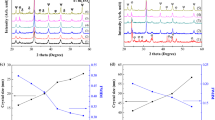Abstract
The difference of intermediate products, microstructure and element concentration in the particles between microwave synthesized samples and conventional samples was responsible for the existence of non-thermal effect in the microwave field. The diffusions of Ba2+, Ti4+ in the microwave field were enhanced, so that the diffusion of Ti4+ could not be neglected as in the conventional solid state reactions. The influences of the microwave field were mainly expressed as diffusion coefficient and the driving force of ionic motion. The intermediate phase Ba2TiO4 which occurred in the conventional solid reaction was not found during microwave syntheses. The quantity analyses based on XRD experimental data show that the reaction dynamics in microwave is suitable for the Carter equation. The activity energy for reaction of BaCO3 and TiO2 in the microwave field was 42.26 kj/mol, which was only one fifth of the conventional reaction.
Similar content being viewed by others
References
Zhang, Z. Z.. Zhong, J. Q.,The Basis of Microwaw Heating (in Chinese). Beijing: Electronic Industry Press. 1988.
Fanslow, G. E., Hall, C. C., Microwave enhancement of chemical and physical reactions,Mat. Res. Soc. Symp. Proc., 1991, 189:43.
Booske, J.H., Cooper, R.F., Dobson, I., Mechanisms for nonthermal effects on ionic mobility during microwave process- ing of crystalline solids,J. Mat. Res., 1992, 7495.
Rothman, S. J., Critical assessment of microwave enhanced diffusion,Mat. Res. Soc. Symp. Proc., 1994, 347:9.
Beauger, A., Mutin, J. C., Niepce, J. C., Synthesis reaction of metatitanate BaTiO3: Part I, Effect of the gaseous atomosphere upon the thermal evolution of the system BaCO3 and TiO2,J. Mat. Sci., 1983, 18:3543.
Templeton, L. K., Pask, J. A., Formation of BaTiO3 from BaC03 and TiO2 in Air and CO2,J. Am. Gram. Soc. 1959, 42:212.
Li, Y. W., Liu, H. X., Zhang, H. L.etal., Heat effect of BaTiO3 in microwave field and microstructure of BaTiO3,Science in China, Ser. A, 1997, 40(7):779.
Cournil, M., Soustelle, M., Thomas, G., Solid solid reactions, II: Mechanism of barium. Metatitanate synthesis,Oxid. Met., 1979, 13:89.
Amin, A., Spears, M. A., Kulwicki, B. M., Reaction of anatase and rutile with barium carbonate,J. Am. Gram. Soc., 1983, 66:733.
Author information
Authors and Affiliations
Additional information
Project supported by the National Natural Science Foundation of China.
Rights and permissions
About this article
Cite this article
Liu, H., Li, Y., Zhang, H. et al. Mechanism of microwave synthesized BaTiO3 . Sci. China Ser. A-Math. 40, 843–848 (1997). https://doi.org/10.1007/BF02878924
Received:
Issue Date:
DOI: https://doi.org/10.1007/BF02878924



